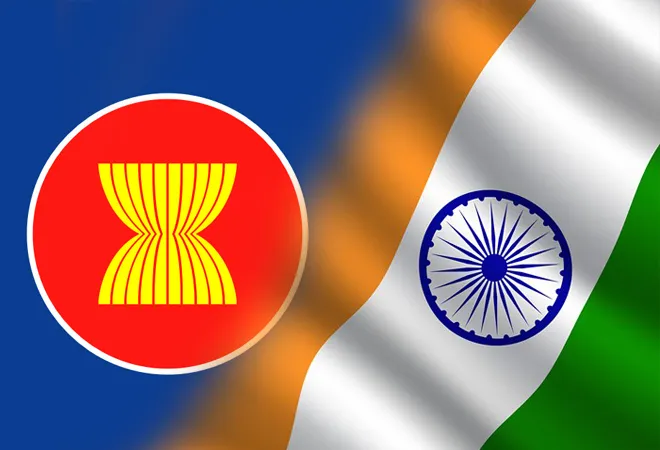
India and ASEAN constitute two of the largest and most prosperous entities. India’s present GDP amounts to US $3.4 trillion, while the combined GDP of the ASEAN countries is over US $4 trillion. India’s population is approximately 1.3 trillion people, while ASEAN’s is slightly below half of the former. These basic indicators stress upon two rising powers in the Asian regional environment, with the capability and the capacities to command remarkable influence, which may eventually be on par with their contemporaries such as the United States (US), China, the European Union (EU), and Japan. Other indicators include the percentage of GDP growth, with both ASEAN and India reaching 5-7 percent growth rates over the past two decades, with India slightly ahead owing to its rising status.
India became a sectoral dialogue partner of ASEAN in 1992, which was followed by an elevation to the apex-level full dialogue partnership, three years later. India also became a member of the influential ASEAN-adjunct regional conference, the ASEAN Regional Forum (ARF), which focuses on political and security dimensions for ASEAN, the very next year. Since the early 2000s, summit meetings, as a consequence of the dialogue partnerships leading to intensification in relations, have denoted India-ASEAN interactions and forums. Given its full dialogue partner status, the peninsular Republic has also become a member of the ASEAN Defence Ministers’ Meeting Plus (ADMM+), which discusses defence issues of pivotal significance between ASEAN countries and all of its dialogue partners, which amount to eight as of today.
India and the ASEAN reveal the vast potential between what institutes a multilateral organisation in the ASEAN of vital significance to its region, and the numerous aspects of a growing superpower in India.
Shifting our focus to the present day, it is apparent that the wide-ranging set of partnerships and complementarities between India and ASEAN reflect a need to engage the maritime medium more constructively, and with due attention paid to specific areas of concern such as maritime security. Together, India and the ASEAN reveal the vast potential between what institutes a multilateral organisation in the ASEAN of vital significance to its region, and the numerous aspects of a growing superpower in India. It is, however, claimed, to an acceptable degree, that ASEAN and India do not profess to a zero-sum partnership despite the large number of positives by way of individual and multilateral relations, which may reflect the perfect relationship between the two pioneering friends.
Contrarily, two-way relations have been marked by a set of differences that have emerged in part due to the intricacies associated with conflicting matters of an imperative importance. Some examples of these are the Asian security dilemma, nuclearisation of the Indian subcontinent led foremost by the Indian union, a plethora of issues concerning the implementation of an ASEAN-India Free Trade Area (AIFTA), and the balance of power that risks being left ‘off balance’ and bearing the possibility of having to assume an anarchic nature owing to the region’s delicate current balances.
India-ASEAN relations in the maritime domain: An analysis
India and ASEAN engage in maritime diplomacy that significantly augments the maritime profile of the region. This has led to increased bilateral maritime trade, interactions at the level of senior officials and ministers, and bilateral naval cooperation resulting in exercises and suchlike. This diplomacy is being undertaken to meet the wide-ranging tactical objectives of their respective maritime forces and to enhance maritime domain awareness (MDA) of the Indian and Southeast Asian maritime regions. Individually, India subscribes to deepened defence relations with a host of ASEAN countries, and partakes in routine military diplomacy, which even includes the maritime domain. With ASEAN as a unit which subscribes to cooperative and collective security models to cater to the diverse security needs of its members and to vouch for those security interests that stand impeded—as mentioned in page 3 of the ASEAN Outlook document on maritime security concerns and cooperation—India’s interactions are largely oriented to the domains of geo-economics and bilateral cooperation.
The issues resonated by the maritime domain are multi-fold and require concerted cooperation, combined attention, and a diverse array of wide-ranging measures that can alter the status quo. In addition to traditional threats, non-traditional ones in the form of marine pollution leading to environmental degradation like illegal, unreported, and unregulated fishing (IUU) of which Indonesia is known to be the most afflicted with financial losses tantamount to billions of dollars; maritime piracy and crime; threats to the maritime tourism industry which contributes substantially to the Gross Domestic Products (GDP) of the ASEAN countries and ASEAN as a whole; natural disasters and calamities; and many other such issues continue to sabotage prospects for peace, stability, and safety.
India subscribes to deepened defence relations with a host of ASEAN countries, and partakes in routine military diplomacy, which even includes the maritime domain.
Of ASEAN’s members, India obliges towards the conduct of coordinated patrols (CORPATs) with Indonesia and Thailand, aimed at inhibiting maritime piracy in a region that was once dubbed the world’s most dangerous. CORPATs between navies seek to develop capabilities to deter ‘from-the-sea’ and ‘at-sea encounters’ with pirates and sea-inclined criminals, and also to give an impetus to humanitarian undertakings and disaster-impact alleviation in the much-troubled Indian Ocean Region (IOR). Bilateral naval exercises aimed to achieve strategic adeptness such as those between India and Indonesia (Samudra Shakti), and India and Singapore (SIMBEX), have considerably upscaled the prowess of their respective navies, while having ushered in an era of tailored naval cooperation between the many maritime forces in the region, which are of immense importance to address the security dimensions within ASEAN.
India and ASEAN in the maritime domain today
ASEAN released the widely circulated ‘Outlook’ document, espousing its broad-based approach to the Indo-Pacific region. Along with France and the US—the two other major powers that purport to a paramount set of interests exclusive to the Indo-Pacific region—ASEAN made it clear that it prioritises the Indo-Pacific, given its immense strategic primacy amidst the ongoing travails and turmoil resulting in sustained turbulence, in the vast terrestrial and maritime expanse that the Indo-Pacific occupies. The Outlook document even stressed ASEAN’s continual and renewed commitment to the maritime domain, which necessitates cooperation with India owing to the converging seas and oceans in the peripheries of the maritime domains of the two partners.
ASEAN’s initiatives in the maritime domain do involve multilateral aspects, which are deliberated upon via the ASEAN Maritime Forum (AMF) and the Expanded ASEAN Maritime Forum (EAMF). Both have witnessed several iterations, which intuitively indicate the norms and ideas within the ASEAN system as concerning the maritime expanses that border them. All-round aspects concerning the maritime domain are discussed, including the deliberations surrounding the United Nations Convention on the Law of the Sea (UNCLOS), maritime training and education, connectivity and infrastructure, regional development, and issues pertaining to the scientific ends of the maritime environs. India has been an integral member of the EAMF, with its constructive involvement in all of the seven iterations of the EAMF since its inception in 2012.
Notwithstanding the convergence of the maritime domain between India and ASEAN, bilateral relations need to be cultivated on the basis of India’s strong historical relations and bonds with the founding members of ASEAN individually, as well as the later accessions. The ASEAN has much to offer to India in terms of maritime cooperation, maritime diplomacy, and the trade of high-end military-maritime weapons and other equipment. Other factors include the urgency to jointly address the diverse security concerns that thrive in the domain and to cater to the diverse set of environmental and ecological concerns that may hinder a progressive future.
The ASEAN has much to offer to India in terms of maritime cooperation, maritime diplomacy, and the trade of high-end military-maritime weapons and other equipment.
India and ASEAN have also notably agreed to provide an impetus to maritime cooperation having recognised the need to merit attention to the domain in several forms and features. ASEAN lies at the very centre of the chief causes of global consternation, amidst the troubles and turmoil of the South and East China Seas. The region is also infested by piracy and maritime crime, drug trafficking, human smuggling, ship hijackings, and other such happenings, which have lately drawn the attention of the region’s powers to adopt an investigative demeanour, and distinctly curb the menace. Add to that, the region is located in between the many geographical fault lines which have come to characterise Asia, with natural disasters such as tsunamis and earthquakes frequenting the terrestrial and maritime contours of the region and causing a damning impact in terms of the loss of lives and property.
The road ahead for India and ASEAN
India-ASEAN relations, with seemingly ample evidence on offer, are crucial for the geo-Asian mix, especially in the domain encompassing the straits, seas, and oceans of the Asian and Pacific regions. For the two entities of ASEAN and India to shape the delicate balances, which may otherwise be primed for a prosperous future, remains a persistent necessity. It must be mentioned that ASEAN and India are relatively well posited when it comes to the budding relations in several areas, including the maritime domain. Given the lack of historical grievances of the type that stymie relations between ASEAN countries with respect to China, India has cultivated strong bonds of historical and contemporary significance that can offer the region a natural recourse to peace, unlike the many conflicts that the ASEAN countries are involved in with China.
ASEAN and India are yet to fully converge on a joint vision for the maritime domains of Asia and the world at large. ASEAN’s ‘Outlook’ offered a strategy, while India confessed to a vision for the Indo-Pacific through Indian Prime Minister Narendra Modi’s SAGAR programme (Security And Growth for All in the Region). The other immensely significant regions such as the Indian Ocean and the Asia-Pacific regions too are in dire need of long-term and multi-faceted strategising. This matters as far as India and its blue-water maritime forces are concerned, while these strategies must also take into account the varying interests of India’s partners, such as ASEAN, and ensure that there are no spillovers or detrimental effects. Points nine and ten in the joint vision statement released during the ASEAN-India Commemorative Summit (January 2018), which heralded 25 years of relations between the two, have emphasised several aspects of cooperation such as freedom of navigation and the security of shipping lanes. The impetus, hence, lies upon India and ASEAN to ensure a prosperous future for one and all in the maritime domain.
The views expressed above belong to the author(s). ORF research and analyses now available on Telegram! Click here to access our curated content — blogs, longforms and interviews.




 PREV
PREV


